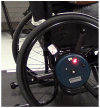Real-Life Wheelchair Mobility Metrics from IMUs
- PMID: 37631711
- PMCID: PMC10458841
- DOI: 10.3390/s23167174
Real-Life Wheelchair Mobility Metrics from IMUs
Abstract
Daily wheelchair ambulation is seen as a risk factor for shoulder problems, which are prevalent in manual wheelchair users. To examine the long-term effect of shoulder load from daily wheelchair ambulation on shoulder problems, quantification is required in real-life settings. In this study, we describe and validate a comprehensive and unobtrusive methodology to derive clinically relevant wheelchair mobility metrics (WCMMs) from inertial measurement systems (IMUs) placed on the wheelchair frame and wheel in real-life settings. The set of WCMMs includes distance covered by the wheelchair, linear velocity of the wheelchair, number and duration of pushes, number and magnitude of turns and inclination of the wheelchair when on a slope. Data are collected from ten able-bodied participants, trained in wheelchair-related activities, who followed a 40 min course over the campus. The IMU-derived WCMMs are validated against accepted reference methods such as Smartwheel and video analysis. Intraclass correlation (ICC) is applied to test the reliability of the IMU method. IMU-derived push duration appeared to be less comparable with Smartwheel estimates, as it measures the effect of all energy applied to the wheelchair (including thorax and upper extremity movements), whereas the Smartwheel only measures forces and torques applied by the hand at the rim. All other WCMMs can be reliably estimated from real-life IMU data, with small errors and high ICCs, which opens the way to further examine real-life behavior in wheelchair ambulation with respect to shoulder loading. Moreover, WCMMs can be applied to other applications, including health tracking for individual interest or in therapy settings.
Keywords: IMU; activities of daily living; shoulder; spinal cord injury; wearable sensors; wheelchair propulsion.
Conflict of interest statement
The authors declare no conflict of interest.
Figures







Similar articles
-
Feasibility and Validity of Wearable Sensors for Monitoring Temporal Parameters in Manual Wheelchair Propulsion.IEEE J Biomed Health Inform. 2024 Sep;28(9):5239-5246. doi: 10.1109/JBHI.2024.3407525. Epub 2024 Sep 5. IEEE J Biomed Health Inform. 2024. PMID: 38814765
-
A Simple and Valid Method to Calculate Wheelchair Frame Rotation Using One Wheel-Mounted IMU.Sensors (Basel). 2023 Aug 25;23(17):7423. doi: 10.3390/s23177423. Sensors (Basel). 2023. PMID: 37687878 Free PMC article.
-
Machine-Learning-Based Methodology for Estimation of Shoulder Load in Wheelchair-Related Activities Using Wearables.Sensors (Basel). 2023 Feb 1;23(3):1577. doi: 10.3390/s23031577. Sensors (Basel). 2023. PMID: 36772617 Free PMC article.
-
Load and performance monitoring in wheelchair court sports: A narrative review of the use of technology and practical recommendations.Eur J Sport Sci. 2023 Feb;23(2):189-200. doi: 10.1080/17461391.2021.2025267. Epub 2022 Feb 13. Eur J Sport Sci. 2023. PMID: 34974822 Review.
-
Biomechanics and physiology in active manual wheelchair propulsion.Med Eng Phys. 2001 Dec;23(10):713-33. doi: 10.1016/s1350-4533(01)00083-2. Med Eng Phys. 2001. PMID: 11801413 Review.
Cited by
-
An Automated Electronic System in a Motorized Wheelchair for Telemonitoring: Mixed Methods Study Based on Internet of Things.JMIR Form Res. 2023 Nov 8;7:e49102. doi: 10.2196/49102. JMIR Form Res. 2023. PMID: 37776327 Free PMC article.
-
Investigating the Impact of Pressure Relief Performance on the Occurrence of Pressure Injuries and Shoulder Pain in Wheelchair Users with Spinal Cord Injury (PRperf Study): Study Protocol for a Prospective Observational Study.Methods Protoc. 2025 Jun 6;8(3):62. doi: 10.3390/mps8030062. Methods Protoc. 2025. PMID: 40559450 Free PMC article.
-
Validity of IMUs in Comparison to a Marker-Based-Motion Capture System for Spatio-Temporal Parameters During Wheelchair Propulsion.Sensors (Basel). 2025 Jul 29;25(15):4676. doi: 10.3390/s25154676. Sensors (Basel). 2025. PMID: 40807841 Free PMC article.
-
Inertial Measurement Unit and Heart Rate Monitoring to Assess Cardiovascular Fitness of Manual Wheelchair Users during the Six-Minute Push Test.Sensors (Basel). 2024 Jun 27;24(13):4172. doi: 10.3390/s24134172. Sensors (Basel). 2024. PMID: 39000952 Free PMC article.
References
-
- Akbar M., Brunner M., Balean G., Grieser T., Bruckner T., Loew M., Raiss P. A cross-sectional study of demographic and morphologic features of rotator cuff disease in paraplegic patients. J. Shoulder Elb. Surg./Am. Shoulder Elb. Surg. 2011;20:1108–1113. doi: 10.1016/j.jse.2011.03.021. - DOI - PubMed
MeSH terms
LinkOut - more resources
Full Text Sources

